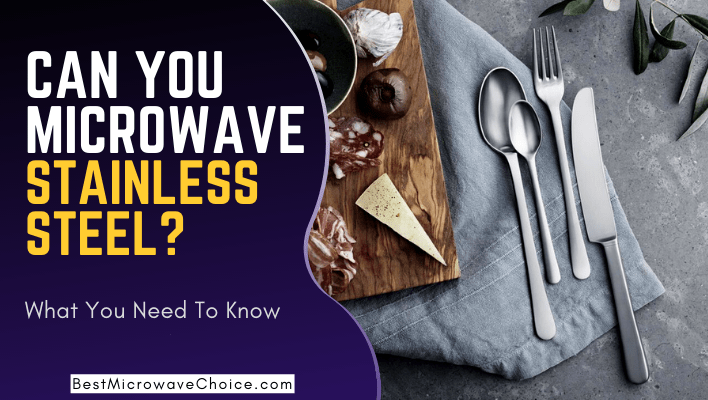Metals have a tricky interaction with microwaves. If you’ve ever seen miniature lightning in your microwave, it’s because you put something metal in it. So, can you put stainless steel in the microwave?
In this article, you’ll learn why putting stainless steel in the microwave is risky and why it isn’t in some cases if you take the right precautions.
Let’s explore!
Can You Microwave Stainless Steel?
It is not good to microwave stainless steel because it reflects microwaves rather than absorbing them. This is a fire danger since it can produce sparks. It’s especially true if the metal is bent into complicated shapes, like forks or several pieces of metal present.
What’s the deal with microwaves and metal?
It’s crucial to understand how this handy gadget works before knowing why you shouldn’t use stainless steel in your microwave.
How does microwave work?
Microwaves are a form of radiation that falls between radio and infrared wavelengths. Most foods absorb these waves, allowing them to be heated in a matter of seconds.
The atomic motion created by these waves helps food to heat evenly. Only when a microwave fails to get waves to the center of the meal, whether it’s a large piece of meat or a pile of leftover pasta with sauce, will it heat unevenly.
You’ll be able to fix the problem if you take a minute to arrange the food on the plate evenly.
Food absorbs the waves through fat, sugar, and water. Microwaves are commonly believed to cook food from the inside out, but this is not true.
If it were, you wouldn’t end up with a Hot Pocket with a block of ice in the middle and a face-meltingly hot outside.
Microwaves heat food by spinning loose molecules, which generate heat energy through friction. Heat is distributed evenly by using convection.
The myth is that this approach warms the insides of foods faster than an oven does without browning or scorching the edges.
Related: Can You Put a Metal Bowl in the Microwave?
Can Stainless Steel Go in the Microwave?
Microwave-safe stainless steel is not recommended. Stainless steel will not only keep the heat from the microwaved food out but may also harm your microwave, causing a portal fire.
Microwaves are perfect for reheating cold coffee in the workplace or at home. Fresh coffee may be kept warm in a styrofoam cup or tumbler for a long time, but it starts to lose heat in a mug.
These stainless steel travel cups do not belong in the microwave, regardless of whether we realize it or not.
What happens when you microwave stainless steel?
To understand why stainless steel should not be used in the microwave, consider what happens when stainless steel cups, flatware, or bowls are placed in the microwave.
Microwaves function by causing friction between water molecules in food, generating heat. As a result, heat does not penetrate plastic, ceramic, metal, or glass because it is not in direct contact.
Stainless steel reflects microwaves while heated in the microwave. Microwaves pull electrons into metal, causing a thin sheet of metal to heat up rapidly enough to burn the appliance and maybe cause a fire.
Consider to know about microwaving stainless steel
From reheating to defrosting, the microwave makes meal preparation a breeze. According to our knowledge, stainless steel should not be microwaved for safety reasons because the material is not microwaving safe.
There are a few things you should know about microwaving stainless steel to gain a better understanding:
- In the microwave, different forms of stainless steel react differently. Microwaving items with sharp edges and corners, such as forks, causes charged particles to travel to the fork’s edges, causing sparking.
- Microwaving any dishes with metallic trim is not suggested. These metallic trims will overheat and generate an electric arc in the microwave, damaging the dish and the microwave.
- Allow no more than 30 seconds for a stainless steel spoon to heat in a bowl loaded with food. To avoid sparking, keep the metal spoon in the microwave for a brief time and not overcook it.
- Avoid placing stainless steel items too close to the microwave’s walls. It may spark, resulting in a fire in the microwave.
- To avoid wrinkles when using aluminum foil in the microwave, lay it flat and round the edges, making sure there are no sharp angles or points that could cause a spark.
Related: Can You Put a Microwave on a Metal Shelf?
Which metals are safe to use in a microwave?
It isn’t to suggest that you can’t use any metal in a microwave. Materials like aluminum foil, for example, can be safely microwaved in modest quantities.
Microwave interference is avoided by placing a thin piece of aluminum, tin, or steel in the microwave that lies flat and does not touch any of the microwave’s interior surfaces.
However, when microwaving aluminum foil, keep an eye on it and don’t let it heat up for too long.
Can stainless steel explode in the microwave?
Yes, some stainless steel explodes in the microwave, but not all stainless steel does. A twist tie, a nail, or crockery with metal trim will not explode in the microwave, as will any spherical metal object like a spoon, fork, or coin.
Contrary to popular belief, larger metal things are less explosive than smaller metal objects.
Because microwave wattage and power vary depending on the brand, manufacturer, and model, we strongly advise against using utensils such as forks, spoons, or knives in the microwave.
These metal particles can harm not only your food but also your microwave oven.
Related: Can You Microwave Glass Jars?
Is it safe to microwave 304 stainless steel?
No, you cannot use 304 stainless steel in a microwave. In reality, grade 304 stainless steel, often used in utensils, food handling, and processing equipment, is the most popular material containing chromium and nickel elements.
304 stainless steel is excellent for preparing, storing, and dining rather than reheating, cooking or defrosting food in the microwave. It’s well-known for its high heat and corrosion resistance. However, it is not microwave-safe.
Conclusion
To summarize, can you put stainless steel in the microwave? Microwaving stainless steel is not recommended. The following things should not be microwaved: cup, bowl, thermal mug, spoon, fork, or knife.
Metal reflects rather than absorbs microwaves when defrosting, cooking, or reheating in the microwave. As a result, potentially harmful situations such as fire or dangerous sparking may occur.
Aluminum foil can be microwaved without trouble when handled properly, but stainless steel is not the case. Although it is not suggested, a spherical stainless steel design may prevent the microwave from exploding for less than 30 seconds.
Stainless steel with a 304 grade should be avoided in the microwave at all costs. These should only be used for storing and handling food, not for cooking.
Microwaving is a safe method of cooking. However, it does not always work with all materials. If you’re reheating cold coffee or stirring soup in the microwave, use microwave-safe plates and utensils for the best results.
Recommended Posts:
Best Small Microwave – Reviews & Buyer’s Guide
12 Best Microwaves in the Market – Reviews & Buyer’s Guide
Best Microwave Under $100 – Reviews & Buyer’s Guide

Hey! I’m Camila Carter, a dedicated writer of this beautiful blog. Here, I write to provide you the unbiased reviews and buying guides for the very best of microwaves found in the market. I hope you love to read my articles as much as I love to write them for you.
